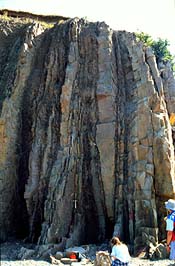The Fossils of Diligent River
 "What makes the Parrsboro area the world's most important
source of Carboniferous trackways is the disposition of the beds --- nearly vertical and
at right angles to the shore." (Carroll, R. L. et al. 1972. "Vertebrate
Palaeontology") "What makes the Parrsboro area the world's most important
source of Carboniferous trackways is the disposition of the beds --- nearly vertical and
at right angles to the shore." (Carroll, R. L. et al. 1972. "Vertebrate
Palaeontology")
Each bed (or layer) of rock is called a horizon. Examinations of the site revealed
footprints in a number of horizons, including microsaur prints and tracks made by a larger
tetrapod, possibly an amphibian. The plant fossils include upright fern stems (possibly Sphenopteris
sp.) with fronds trapped between the parallel beds. These ferns were present in
several horizons.
 Coarse
sandstone units contain plant fragments from Calamites
sp., Lepidodendron sp., Sigillaria sp. and Cordaites sp.
More finely grained siltstones were also noted with delicately preserved Sphenopteris
sp, Alethopteris sp., Lepidodendron
sp. and Whittleseya sp, as well as smaller microsaur or amphibian tracks and
arthropod tracks. Spirorbis were noted attached to fern stems. Coarse
sandstone units contain plant fragments from Calamites
sp., Lepidodendron sp., Sigillaria sp. and Cordaites sp.
More finely grained siltstones were also noted with delicately preserved Sphenopteris
sp, Alethopteris sp., Lepidodendron
sp. and Whittleseya sp, as well as smaller microsaur or amphibian tracks and
arthropod tracks. Spirorbis were noted attached to fern stems.
In the exposed panel of rock originally discovered by Cody McLellan, there are at least
four different types of footprints. One of these trackways could be the first of its kind
ever found!
 |
 |
 |
| Diligent River Intro |
Important Sites Home |
Research and Excavation |
|




 "What makes the Parrsboro area the world's most important
source of Carboniferous trackways is the disposition of the beds --- nearly vertical and
at right angles to the shore." (Carroll, R. L. et al. 1972. "Vertebrate
Palaeontology")
"What makes the Parrsboro area the world's most important
source of Carboniferous trackways is the disposition of the beds --- nearly vertical and
at right angles to the shore." (Carroll, R. L. et al. 1972. "Vertebrate
Palaeontology")  Coarse
sandstone units contain plant fragments from
Coarse
sandstone units contain plant fragments from